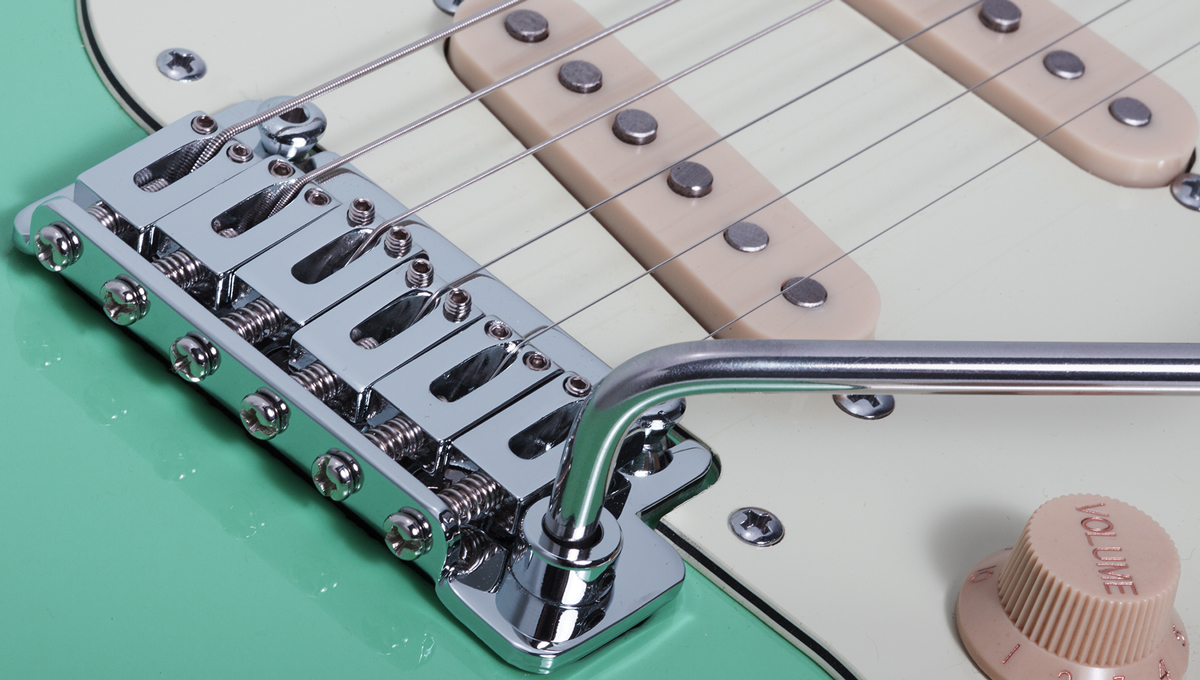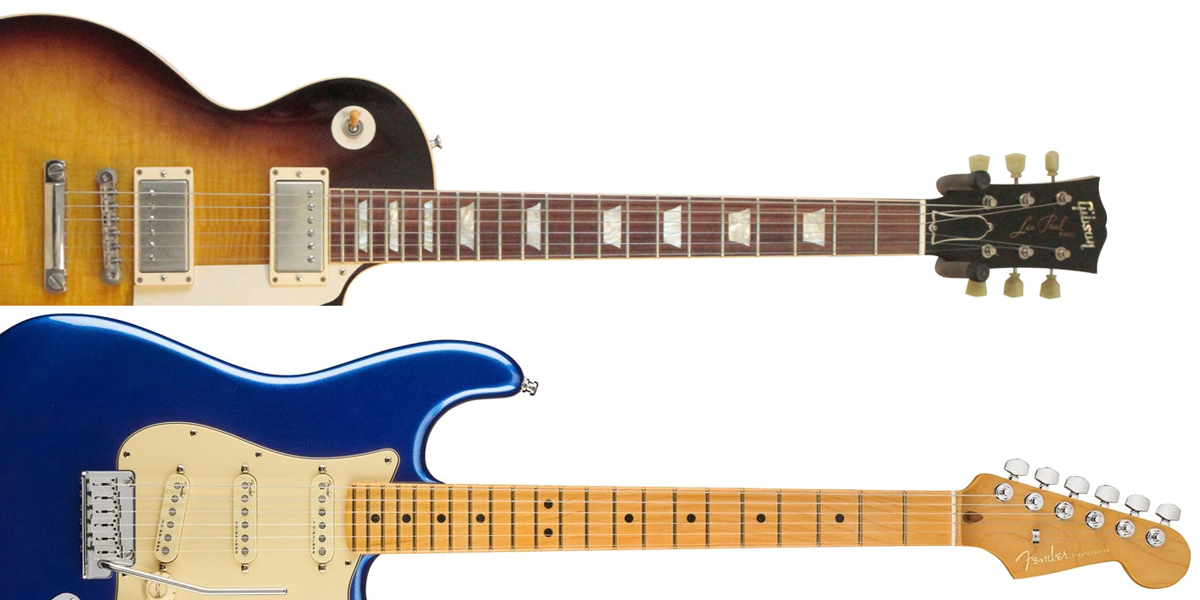If you’re a guitarist looking to choose the perfect instrument, details are everything. And with a growing number of players buying their gear online, carefully sifting through a candidate guitar’s spec sheet to tick off all those must-have features is more essential than ever before. But amidst all those tempting pickup options and flashy finishes, one crucial spec often slips under the radar: scale length.
Despite its importance, scale length often gets overlooked when buying a new guitar. Look closely, and you’ll see that some guitars have scale lengths that are different to others. Some are longer, some shorter – but what difference does it make? This might all sound a bit confusing at first, but stick with us and you’ll soon discover some very good reasons why various scale lengths exist – and why you should pay attention to this figure when you’re shopping for your next axe!
Table of Contents
- What Does Scale Length Mean?
- How Do You Measure Scale Length?
- Why Does Scale Length Matter?
- Does Scale Length Affect Playability?
- String Gauge vs. Scale Length
- Does Scale Length Affect Tone?
- What Are the Most Common Guitar Scale Lengths?
- Is Guitar Scale Length Important?
- FAQs
- Further Reading
What Does ‘Scale Length’ Mean?
Put simply, a guitar’s scale length is the distance between the instrument’s nut and the bridge – or more precisely, the vibrating length of the string. When you pluck a note, the section of string that vibrates (and therefore produces sound) is the part that’s stretched between the nut (just before the headstock) and the saddle on the bridge. When we say scale length, that’s the bit we’re measuring.
So, how important is scale length? It plays a bigger role than you might think! It affects everything from the spacing between frets, how the strings feel under your fingers, and even the overall tone of your guitar. When you see a spec sheet that lists a scale length of 24.75″, 25.5″, or maybe something a bit more unusual, that number’s not just for show. It’s a helpful clue about what you can expect in terms of sound and playability. Whether you’re after a tighter string response for shredding or you’re a blues player looking to lay down some soulful, buttery bends, scale length is one of the main ingredients that will shape your experience.
How Do You Measure Scale Length?
Is scale length starting to make sense? Well, unfortunately, it’s about to get a bit more confusing! You see, a guitar’s scale length measurement is not completely consistent or accurate. Instead, think about it as more of a guide. In most cases, a guitar bridge will feature individual string saddles you can move forward and back, allowing you to intonate each string to ensure that the fretted notes sound in tune across the fingerboard. You might need to move certain string saddles closer to the nut to compensate for notes that are a little flat. Others might need to move backwards to prevent notes from ringing sharp. In either case, each string will likely end up having a slightly different scale length.
So, if that’s the case, how do you accurately measure a guitar’s overall scale length? Measuring each string and averaging them isn’t ideal – it’s time-consuming and unnecessary. Instead, there’s a much simpler method that most luthiers follow. The best way to determine the scale length of a guitar is to measure the distance between its nut and the centre of its 12th fret. Once you’ve got that value, go ahead and double it. Voila – you’ve just established your guitar’s scale length.
One other important thing to note is that we typically measure guitar scale lengths in inches. It might seem a bit old-fashioned, but the world’s largest guitar brands are American – and for the most part, the USA still uses the older imperial system, so measuring in inches has remained the industry standard. Of course, plenty of brands convert these inches to metric measurements nowadays, so the rest of the world can interpret them more easily!

Why Does Scale Length Matter?
As we touched on earlier, scale length is an important thing to think about when you’re shopping for a new guitar. Some guitars have relatively short scale lengths, others are a bit longer. But what difference do these numbers make? In these next sections, we explain exactly how scale length affects the playability and sound of guitars.
Does Scale Length Affect Playability?
Scale length plays a big role in shaping how a guitar feels when you play it. This will be old news for experienced guitarists, but if you’re new to all things six-string, this information can easily fly under the radar. Naturally, the best way to learn the difference between different scale lengths is by getting your hands on a few different instruments and trying them out for yourself. But if you’re shopping online, a bit of knowledge goes a long way – so we’ll do our best to bring you up to speed!
Fret Spacing
When you’re comparing different scale lengths, the most noticeable difference you’ll see is fret spacing. On a shorter-scale guitar, like a Gibson Les Paul (24.75″), frets are slightly closer together than they are on a Fender Stratocaster (25.5″). This is because as scale length increases, so does the distance between frets.

On guitars with similar scale lengths, any difference in fret spacing is marginal, so most players wouldn’t feel any discernible difference. But compare a typical electric guitar against something like a baritone guitar with a 27″ scale length, and you’ll find a much more perceivable distance between its frets. It’s therefore important to find a guitar with a scale length that’ll suit the size of your hands. If you have small hands, a short-scale guitar like a Fender Mustang (24″) will feel more comfortable to play than a hefty baritone!
String Tension
The other important playability variable that scale length affects is string tension. The key thing to remember here is that the longer a guitar’s scale is, the greater the tension needs to be to bring its strings up to pitch. On the flip side, a guitar with a short scale length requires less tension for its strings to be brought up to pitch.
With that in mind, let’s use the Les Paul vs. Stratocaster scale length example again. If you fitted the same gauge of strings to each of these guitars and tuned them both to standard, you’d notice that the Les Paul would feel more forgiving to play, requiring less effort to bend strings and apply vibrato. A Strat, on the other hand, would have tighter and more rigid-feeling strings – that’s because they’re being subjected to a higher amount of tension.
String Gauge vs. Scale Length
When it comes to string tension, scale length only makes up one half of the equation; string gauge also plays a big part. Depending on how you like to play, the scale length of your instrument, and the tuning you want to play in, you can use different string gauges to help achieve the desired outcome. Of course, your choice of string gauge can also compensate for certain scale lengths. So, if you’re worried that the strings on your Les Paul feel too floppy, don’t fret! Simply try switching to a slightly bigger gauge for a stiffer playing experience.
For example, if a long-scale 27″ baritone guitar is fitted with a set of 10-46 gauge strings, it might well feel a little difficult to play. The high amount of tension means you’d need to apply a decent amount of force to bend the strings. But stick a thinner set of strings on and you’ll resolve this issue, as their tension would be lower when brought up to pitch.
At the other end of the spectrum, a shorter 24″ scale guitar with 9-42 gauge strings might feel far too slinky to play, and you may find yourself fretting notes sharp. Fitting heavier gauge strings would create a bit more tension, giving the guitar a stiffer and more controllable feel.
Does Scale Length Affect Tone?
While pickups and tonewoods often get the spotlight, scale length also plays a key role in shaping tone.
As guitars with a longer scale length typically have more string tension by default, they tend to produce a strong and focused sound with great low-end clarity. This is what gives Stratocasters and Telecasters their famously bright and snappy tones. Going a step further, it’s also the reason why extended-range instruments, like baritones and 7/8/9 string guitars, typically have much longer 26″ – 28″ scale lengths – it helps ensure that notes played on lower strings sound tight and clear.
Guitars with short scale lengths often sound warmer and more rounded than guitars with longer scales. That’s because the lower amount of tension allows their strings to vibrate more freely – part of the reason why Les Pauls have a thick, harmonically rich sound and sustain for days.
But what if you want a guitar that offers the crisp note definition of a Fender, combined with the fullness and forgiving playability of a Gibson? PRS has joined the conversation. Back in the mid-’80s, Paul Reed Smith wanted to create guitars that could fill the gap between Strats and Les Pauls. With his flagship Custom 24 and 22 models, Smith pioneered a 25″ hybrid scale length that could give both Fender and Gibson users a familiar feel and sound, while also creating something completely new and original of his own. The rest, as they say, is history.
What Are The Most Common Guitar Scale Lengths?
As you might have guessed by now, 24.75″ and 25.5″ scale lengths are by far the most common guitar scale lengths you’ll come across. Almost all Gibson and Epiphone models will have the former, while the majority of Fender and Squier guitars feature the latter.
However, many modern Ibanez, ESP, Schecter, and Chapman guitars also opt for 25.5″ scales. This is to cater for contemporary players who often prefer punchier and more articulate guitar tones, especially if they’re into metal. But that doesn’t mean all guitar manufacturers are following this trend. For instance, a lot of brands that create Gibson-inspired instruments still adhere to shorter scale lengths.
Below, we’ve created a list of the most common scale lengths that you’ll come across when shopping for a new electric guitar, and noted which brands/models feature them:
| Guitar Brand/Model | Scale Length (inches) | Scale Length (mm approx.) |
| Fender Jaguar / Mustang / Duo Sonic | 24 | 610 |
| PRS 245, Gretsch (various models) | 24.5 | 622 |
| PRS McCarty 594 | 24.594 | 624.7 |
| Gretsch (various models) | 24.6 | 625 |
| Ibanez Artcore (various models) | 24.7 | 627 |
| Gibson Les Paul / SG / Designer / ES | 24.75 | 629 |
| PRS Custom 22 / 24, D’Angelico (various models) | 25 | 635 |
| Fender Stratocaster / Telecaster / Jazzmaster / Lead | 25.5 | 648 |
| Schecter, Ibanez, ESP & Chapman (various 7-string guitars) | 26.5 | 673 |
| Reverend (various baritone guitars) | 26.75 | 679 |
| Ibanez & ESP (various 8-string guitars) | 27 | 686 |
| Chapman (various baritone guitars) & Schecter (various 8-string guitars) | 28 | 711 |
| Gretsch (various baritone guitars) | 29.75 | 756 |
Is Guitar Scale Length Important?
The short answer is – yes. If you’re particularly sensitive about how your guitar feels to play, scale length definitely matters. But as we’ve discovered, scale length can also affect how an instrument sounds and how easy it is to pull off certain techniques, like string bending.
Of course, scale length is just one of many things you need to consider when you’re looking for a new guitar. The tonewoods used, construction, hardware, and electronics are all just as essential, so it’s worth doing plenty of research before you make your purchase. If you’re still searching for the guitar of your dreams, don’t forget to try using the helpful filters on our website to narrow down your search, including the ability to search by that all-important scale length!
FAQs
What does guitar scale length mean?
Scale length is the distance between the nut and the bridge saddles of a guitar, which is the length of the vibrating portion of the strings. It plays a big role in how a guitar feels and sounds, affecting string tension, tone, and overall playability.
How do I measure the scale length of my guitar?
To calculate scale length, just measure from the front edge of the nut (closest to the fretboard) to the centre of the 12th fret, then double that number. So, for example, if the distance to the 12th fret is 12.75 inches, your guitar’s full scale length is 25.5 inches.
Is the scale length of a guitar important?
Yes, scale length has a significant impact on a guitar’s feel and sound. It affects how tight or loose strings feel, how much tension you’ll need to reach pitch, and even the tone of your instrument. If you’re choosing a guitar for a specific playing style or tuning, you’ll need to keep scale length in mind.
Does the scale length of a guitar affect its playability and tone?
Absolutely. Longer scale lengths tend to have tighter string tension, a snappier response, and more defined low end, which is great for styles like metal or funk. Shorter scale lengths are looser and warmer-sounding. This makes bends easier to perform and can give chords a softer sound that’s ideal for blues, jazz, or classic rock.
Do certain string gauges work better with specific scale lengths?
They can, yes. Lighter string gauges often perform better on longer-scale guitars because they maintain good tension without being too stiff. On shorter scales, heavier strings can help avoid an overly floppy feel and give you a bit more stability, especially if you play in lower tunings. If you’re trying to strike the perfect balance between playability and tone, matching gauge to scale length is one of the first things to tinker with.
Which guitar scale lengths are the most common?
The most common scale lengths are 25.5 inches (often found on Fender-style guitars), 24.75 inches (typical for Gibson-style guitars), and 25 inches (used by brands like PRS). These variations all offer slightly different feels and tones, so it’s worth trying each to see what suits you best.
What is the best scale length for a beginner guitarist?
There’s no single “best” scale length for beginners, but shorter scales (like 24″–24.75″) do tend to be a bit easier to handle. The frets are closer together, and the strings feel slinkier under your fingers, making learning chords and bends a little bit more forgiving when you’re starting out. If you’re searching for a reliable, shorter-scale guitar to learn on, give the Fender Mustang or Gibson Les Paul Junior a look over.
Can I change the scale length of my guitar?
Technically, no: scale length is fixed. But in practice, small adjustments can be made via the bridge. As a guitar’s official scale length is determined by the physical distance between the nut and the bridge, you can’t change that without doing something pretty major (and very much not recommended!) surgery. However, as many guitars feature bridges with individually adjustable bridge saddles, you can tweak the de facto scale length of individual strings to improve tone and tuning stability. And don’t forget, you can also experiment with different string gauges and tunings to alter the feel and response of your guitar.
Does scale length affect tuning stability?
Indirectly, yes. A longer scale length increases string tension, which can help reduce the risk of your strings going out of tune when you play hard. But tuning stability depends on more than just scale length – string quality, nut and tuner design, and how well the guitar is set up can all come into play.
Is scale length important for different music styles?
It certainly is! Players who use lower tunings (like in metal or post-rock) often favour longer scale lengths because they help maintain clarity and tension in the low end. At the same time, blues and jazz players might prefer the warmer, more forgiving feel of shorter scales. That said, there are no hard rules here – it’s all about what feels and sounds right to you.
Want To Learn More?
Interested in finding out more about music gear and expanding your knowledge? Click here to view all of our Learn articles! For more information on the other topics mentioned in this guide, check out our related articles:



Responses & Questions